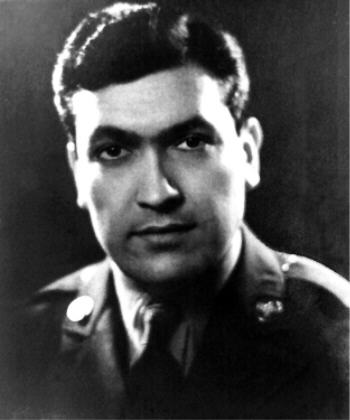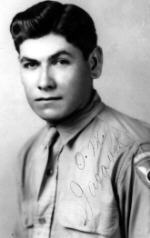|
Biography of Francisco Xavier Jacques
Submitted by: Hiram Jacques |
||||||||||
|
||||||||||
WWII
Veteran
Francisco Xavier "Frank" Jacques was the descendant of a hearty and faithful people, possibly of Basque origin, who had settled in Zacatecas, Mexico about 400 years ago. Frank’s direct ancestors had settled in Santa Ysabel, Chihuahua, Mexico, during the early 1700’s, and later migrated to Coyame, Chihuahua in the late 1800’s, where they were big land owners. After decades of droughts, Apache and Comanche attacks, revolutions, and invasions by the U.S. and France, Frank’s great-grandfather, Tomas Jaques de Salazar, along with his family, emigrated by wagon from Coyame, Chihuahua, Mexico to Fort Stockton, Texas in 1870. All of their money, which was contained in two large wooden boxes, was stolen from them somewhere in Texas, and they made their living in Fort Stockton as irrigation farmers. Frank’s grandfather, Honesimo Jaques, who was married to Salome Rodriguez, a Tarahumara Indian and daughter of an Indian scout, is said to have helped in the building of the Catholic church in Fort Stockton, Texas, and decided to stay in Fort Stockton until the completion of the church in 1875. Tomas Jaques and the rest of the family had already moved on to Ben Ficklin, Texas around 1871-72, next to San Angelo, Texas, leaving Honesimo and his family behind.
Frank’s father, Selso Jaques, was born
in Fort Stockton, Texas in 1874, and in 1875, Honesimo and his
family then joined the other Jaques family members at Ben Ficklin,
Texas.
Frank’s great-grandfather, Tomas Jaques, and
two son’s of Tomas, Trinidad and Jesus Jose, were three of the
founding fathers of Tom Green county because they petitioned for the
formation of Tom Green county in 1872.
Frank’s ancestors were included with the
first registered voters and tax payers in Tom Green county.
In 1882, a great flood destroyed most of the
town of Ben Ficklin, and in 1886, Frank’s grandfather, Honesimo, and
a brother, Adriano, moved on to a small village 15 miles from San
Angelo called Knickerbocker, Texas, where a Texas historical marker
mentions the Jaques family as being one of the first families to
settle in the town.
Frank’s father, Selso Jaques, grew up in
Knickerbocker, Texas, where he developed his many talents as a
cowboy, farmer, musician, and singer.
In 1905, Selso married
Maria Maldonado, daughter of Fidel
Maldonado and Francisca Ochoa, land owners next to R. F.
Tankersley’s cattle ranch. Francisco "Frank" Xavier Jacques, the third child of Selso Jacques and Maria Maldonado, was born on July 14, 1917 at the Tankersley cattle ranch, which was a few miles north of Knickerbocker, Texas. Frank’s sibling’s were Jesus, born in 1912, who died as an infant, Trinidad, born in 1914, Onesimo, born in 1923 in Rotan, Texas, and an adopted sister, Eloisa Ybarra, born in 1925, the infant niece of Maria Maldonado. The Tankersley ranch, owned by R. F. Tankersley and his second wife, Conchita Maldonado, was one of the first cattle ranches started in Tom Green county during the 1860’s. At the time of Frank’s birth, Selso Jacques, was R.F. Tankersley’s ranch foreman, and Maria Maldonado, was the niece of Conchita Tankersley. After the death of R. F. Tankersley, the Tankersley ranch was sold in 1920, and Selso moved his family to a leased farm just south of Hobbs, Texas. In 1925, Selso bought 44 acres from D. Trammel in Sweetwater, Texas, where they raised crops and livestock. As young boys in Sweetwater, Frank and his brother Trinidad, would help their father with his small farm and also drive around the neighborhoods in a truck selling milk. The family would also sell their crops to the local stores. The family lived a vibrant life where Christian faith, hard work, musical instruments, singing, dancing, and large family gatherings were a major part of their lives. Selso would also hold Thursday prayer meetings at his house for the neighborhood families and help feed those that needed a helping hand. The
town of Sweetwater was extremely segregated at this time, with
Mexican-Americans and Blacks living “on the other side of the
tracks” on the west side of town.
Even after death at the cemeteries, minority
graves were separated from Anglo graves.
The Anglo community was reluctant in
providing Mexican-Americans with funding for schools or even
providing basic necessities for the minority community.
The first Mexican-American school available
to Frank in 1925 was a small rundown building made of 1x6 lumber
with gaps between the boards, which allowed the wind to blow through
the school, and there was a wood-burning stove on the inside for the
cold weather.
Mexican-American students were of various
ages all grouped together as one class with even some students
already having facial hair.
The classes were rather unstructured and in
disarray, and the teachers were Mexican-Americans who had moved to
Sweetwater.
Mexican-Americans were not welcomed in the
town’s barber shops, restaurants, and various other places of
business.
The downtown Ritz movie theater allowed
Mexican-Americans and Blacks, but only through the second-floor
backdoor, which was accessible with stairs and which led to the
inside balcony.
They were not allowed to use the theater
bathrooms but had to go across the street to use the courthouse
bathrooms.
During the 1930’s, the local
Mexican-American community raised the funds to build a small brick
schoolhouse named Emilio Carranza, and sometime after WWII, one
teacher at the school was a local Mexican-American WWII veteran,
Ruperto Rodriguez, who had survived injuries after the attack on
Pearl Harbor.
Ruperto was married to Frank’s adopted
sister, Eloisa Ybarra.
The school’s first-grade teacher was a
beloved elderly women, an Arkansas transplant, known as Mrs. Monk,
with a heart of gold, who would even carry food to the poor
Mexican-American families by walking along the railroad tracks to
the Barrio.
She was later killed by a train.
At age 15, to make extra money, Frank joined
the WPA public works project and worked alongside adult men to
construct HWY 153 south of Sweetwater.
He also participated in the mass slaughter
and burial of farm animals in order to stabilize their market value.
He had vivid memories of the Depression
years with their dust storms and plagues of jackrabbits, which had
to be rounded up and slaughtered.
As young men, Frank, and his two brothers,
Trinidad and Onesimo, and his father, Selso, began a successful
sheep-shearing business, providing service for many of the local
ranchers, and as sheep shearers, they also traveled to other states.
The business was successful, and the family
made enough money to buy new cars and clothes and hire many
Mexican-American men from their neighborhood. After the U.S. declared war on Japan in 1941, Frank attempted to join the the military in El Paso, Texas, but he was rejected because of his lack of education. On August 18, 1942, when there was a great need for fighting men, Frank was drafted and inducted into the Army Airforce. His younger brother, Onesimo, was sent to fight in the Pacific as a paratrooper, becoming involved in eleven island invasions, displaying acts of bravery, and winning his share of metals. His oldest brother, Trinidad, was asked to remain in Sweetwater in order to continue running the sheep-sheering business since this was also valuable to the war effort. Frank began his active service at Fort Walters in Fort Worth, Texas on September 1, 1942. Exaggerating his educational level and performing fairly well on an exam, Frank was assigned to be trained as a side gunner for a B-17 bomber. Before being shipped to the UK for active duty, he was transferred to Rapid City, South Dakota, then Pocatello, Idaho, followed by Salt Lake City, Utah, and finally Pyote, Texas. He and other Mexican-American soldiers were still refused service at local barber shops and restaurants even while wearing their uniforms. There was an incident when Frank was told by a barber that he did not service Mexicans, and Frank, trying to restrain his anger, slammed the barber shop’s front door, breaking the glass window. During another time, two Mexican-American soldiers were not allowed to eat inside of a restaurant but were forced to eat their food outside in the back alley. Frank suggested to them to finish their food, throw their plates into the trash, and then walk away. While still in Pyote on a 24-hour pass, Frank tried to hitchhike to Sweetwater to see his parents one more time, but the MP’s picked him up on the highway and returned him back to Pyote. The soldiers at Pyote were to be transferred by train to New York and then shipped to the UK, but the soldier’s families could not be informed of this information. One moonlit night, the train carrying my father and the other fellow soldiers was traveling through his hometown of Sweetwater, Texas, but was not allowed to stop. Frank could see his home from the train and with a heavy heart took off a dog tag from his neck and threw it beside the tracks below, not knowing until much later that a small boy would find his tag and give it to his mother. The train’s final stop was in New Jersey, and the soldiers were then transported to New York City with the opportunity to see some of the sights. On May 5, 1943, Frank boarded the Queen Elizabeth in New York harbor and landed in Scotland on May 11th. Assigned to the 8th Army Airforce, 96th Bombardment Group, and 338th squadron, he was initially assigned in southern England to a B-17 ground crew, and this was followed by three months of training using a 35 caliber machine gun and then guarding a runway with a 50 caliber machine gun. He had memorable moments in England up until the Allied invasion of Normandy on June 6, 1944. In London, he saw numerous huge tethered balloons floating above to prevent German fighters from swooping down and straffing people on the ground. He spoke of the brave English people who suffered during the V1 and V2 rocket attacks as they huddled in the underground subways. During better times at Picadilly Square, he saw many people from different countries and cultures such as the soldiers from different countries and even a tall African official or nobleman dressed in his magnificant native costume with feathers on his head. At times, large groups of American GI’s would sometimes fill local pubs and drink all the available lukewarm beer and then mischievously kick in the English umbrellas leaning outside of the pub. A few GI’s would test their intoxicated manhood by picking fights in the pubs with soldiers from other countries. Once, Frank and a few of his GI buddies traded boxes of cigarettes for bicycles made for two, and during one night, while riding their bicycles back to camp, they all plunged into a channel where the bridge had been destroyed. Wearing their heavy overcoats, they barely pulled themselves out of the water, losing their bicycles for good. Frank spoke many times about two Mexican-American soldiers in particular. One a short, dark man from Rosebud, Texas, who had a beautiful English girlfriend with a sincere character and true love for her GI. The other soldiers liked her very much and would treat her like a sister when she visited the camp on her bicycle. Before every date, this short Mexican-American GI would shower and stand on a table completely naked high off the floor while singing and proceeding to powder himself with baby powder in every place imaginable. It was humorous but not a pretty sight. This friend told Frank that he would never return to Texas since there was nothing waiting for him back home, and he ended up marrying the English girlfriend and remaining in England after the war. Another friend was called “Big Joe”. He was a large muscular man from San Bernardino, California, as strong as an ox and skilled at boxing. Big Joe caused a lot of damage in a pub when he was challenged by several English soldiers. Frank, being a musician since his youth in Sweetwater, was once given the opportunity to play a saxophone with a band at a dance with hundreds of couples dancing around a rotating stage. He was
finally assigned as a side gunner on a B-17, which had 10 crew
members, up to 13 guns, and over 8 tons of bombs.
During two months, Frank flew on six bombing
missions over Germany, and he was injured on his sixth mission when
antiaircraft flak ripped through the oxygen hoses inside his B-17.
His lungs were traumatized, and he was
hospitalized for one or two weeks before being reassigned to the
ground crew once again.
Shortly before the D-Day invasion in 1944,
Frank received heart-breaking news that his father, Selso, had died
in Sweetwater of pneumonia three months before receiving the news.
Following D-Day, Frank went into Morocco,
France, Belgium, and Germany, eventually being used for general
service with a rifle.
He was later sent back to England.
His rank actually reached Sergeant level,
but was then reduced back to Corporal for disobeying some orders.
It was ironic that Frank was once ordered by
an officer to give haircuts to the GI’s in a camp even though he
could never get barber service back in Texas.
A large cigar box was placed by a chair to
hold any money that the GI’s wished to donate for their haircuts,
and by the end of the day, the box was full of money.
Frank went to deliver the money to the
officer, but the officer told him that it all belonged to him.
On September of 1945, after three years of
military service, Frank boarded the Queen Mary with thousands of
other GI’s, landed in New York harbor, with the Statue of Liberty
clearly in sight and a one-legged Mexican-American soldier shouting
“la Mujer, la Mujer”, which means “the woman”, the woman”.
Frank later boarded a train and ended up in
Camp Fannin in Tyler, Texas, where he was released on October 5,
1945 with a honorable discharge, Good Conduct Medal, Meritorious
Unit Award, and the European-African-Middle Eastern Campaign Medal
with six Bronze Stars.
He eventually found his way back to
Sweetwater, Texas and arrived during the early morning hours.
Unfortunately, he later experienced a rude
awaking that Mexican-Americans were still not respected even after
fighting for their country.
Frank’s first cousin, a WWII veteran of the
Pacific, was shot and killed by a deputy in Rotan, Texas.
The tragedy stemmed from the cousin using a
filling station bathroom against the wishes of several local Anglo
men.
Frank and his cousin then continued their search for
a friend at a local movie theater, with his cousin waiting in the
car.
Frank left the theater only to find a man in overalls
pistol whipping his cousin sitting in the car.
Trying to aid his cousin, the stranger
slipped between Frank’s legs and came up pointing his gun.
The angered cousin exited the car only to be
shot in the heart as Frank watched in horror.
He was arrested for assaulting a policeman
but later released after a Sweetwater rancher, who respected Frank’s
father, provided a reputable lawyer. From 1945 to 1948, Frank worked as a sheep shearer and at the construction of the Lone Star cement plant, working high upon the steel beams. Mexican-Americans were finally being offered jobs by the local plants, and from 1948 through 1957, he worked at US Gypsum, manually loading sheetrock boards into train boxcars. He also sheered sheep on the side for extra money.
In 1948, Frank married Argentina Galan, who, in 1939, was one of the few Mexican-Americans in west Texas to earn a high school education, with honors. She later earned her beautician license and worked in her profession for 30 years. Frank and Argentina had four children together, Frank Gerard (Jerry), born in 1950, Ruth Renee, born in 1951, Armando, born in 1953, who died as an infant, and Hiram Joel, born in 1954.
Frank left US Gypsum in 1957 and worked at Flintkote Gypsum in the loading department until his retirement in 1981. Frank’s daughter Renee attended Texas Tech University before she married Wayne Kieschnick and presently pursues a career in accounting and assisting her husband in his feed and ranching businesses. Frank’s oldest son Jerry went on to earn two Bachelor of Science degrees in Physics and Electrical Engineering at the University of Texas at Austin and a Master of Science in Mechanical Engineering at the University of California at Berkeley and pursues an engineering career in control systems engineering. The youngest son Hiram went on to earn a Bachelor of Science in Electrical Engineering and Master of Science in Electrical Engineering and pursues an engineering career in computer hardware design. Frank’s wife, Argentina, died on April 19, 1974 after battling kidney failure on a dialysis machine for three years. They were chosen as one of the first couples to pioneer the use of the first dialysis machines in Texas. Frank lived life with great vigor during the last years of his life by backpacking in the mountains of Colorado at age 65, going to social events and dances with his friend Belia Tijerina, and traveling around the U. S. and Mexico.
Frank died on January 12, 1997 and was buried in Sweetwater, Texas next to his wife Argentina.
|
||||||||||


